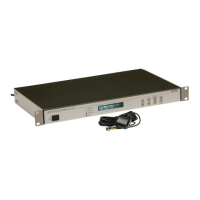158 Options List
C.16.5 Calibration
The clock is now configured for operation. Calibration for phase and amplitude are not necessary for
most applications, however if necessary, can be performed. Specifically, these calibrations have no
effect on system time and frequency measurements, and are unnecessary if only time and frequency
are required.
Uncalibrated phase accuracy is usually less than 0.3 degree, and can be reduced to 0.1 degree typical
and 0.2 degree guaranteed with calibration. Uncalibrated amplitude accuracy is usually less than
1%, which is the typical performance of this measurement. Amplitude accuracy is not guaranteed,
and amplitude measurements are provided primarily to verify that the unit is properly connected
and receiving the expected signal level.
C.16.6 Phase Calibration
The factory performs phase calibration, and supplies the calibration factor with the assembly. To
be effective, it must be entered into the clock non-volatile memory. Entering this factor into the
clock requires connecting the clock to a computer or terminal via the RS-232 interface (see clock
manual). For the computer, use a terminal-emulation program such as Windows HyperTerminal or
Tera Term Pro (see Arbiter website). Send the character “V” to the clock to check that connections
and port settings are correct. The clock should respond with the firmware dates in the format “01
Jan 1997 Op28 02 Jan 1997.”
To send the phase calibration factor to the clock, key in the message:
dd.dd,1084PC, or dd.dd,1088PC, or dd.dd,1093PC
Where dd.dd is the calibration factor in degrees, for example “-0.16”; and 1084, 1093 or 1088 is
the clock model number (a security key to prevent unintentional modification):
-0.16,1084PC
C.16.7 Amplitude Calibration
For amplitude calibration, the format is similar, replacing “PC” with “RV”. The calibration factor
(supplied with boards having a serial number with prefix greater than 97420) is approximately
1.0, and is multiplied by the measured result to generate the displayed value. If an accurate ac
source at 50 or 60 Hz is available (for example, the Arbiter Systems, Inc. Model 1040C Panel
Meter Calibrator), the error (for boards with prefix 97420) can be measured and the correction
factor entered as described. For example, if applying 120 Vrms to the Option 28 assembly, and
the display indicates 119.1 Vrms, the calibration factor is (120.0 / 119.1) or 1.0076. You would
enter “1.0076,1084RV” to calibrate the unit (model 1084B/C). The display should then read close
to 120.0 Vrms. To clear the calibration factor, you may set the unit to factory defaults or send the
command “1,1088RV.” Again, use either 1084, 1088 or 1093 to match the clock model number.

